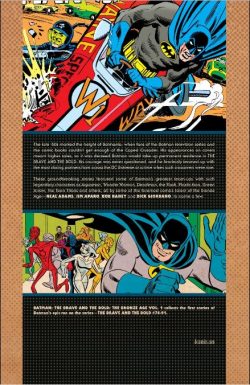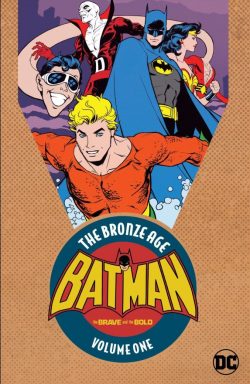

By Bob Haney, Mike Sekowsky, Marv Wolfman, Ross Andru & Mike Esposito, Neal Adams, Bob Brown, Nick Cardy, Irv Novick & various (DC Comics)
ISBN: 978-1-4012-7517-4 (TPB)
The Brave and the Bold began in 1955 as an anthology adventure comic featuring short complete tales about a variety of period heroes: a format that mirrored the contemporary movie fascination with historical dramas.
Written by Bob Kanigher, issue #1 led with Golden Gladiator, the Silent Knight and Joe Kubert’s now legendary Viking Prince. From #5 the Gladiator was increasingly alternated with Robin Hood, but such manly, mainly mainstream romps carried the title until the end of the decade when the burgeoning costumed character revival saw B&B transform into a try-out vehicle like sister publication Showcase.
Issue #25 (August-September 1959) featured the debut of Task Force X: Suicide Squad, followed by Justice League of America (#28), Cave Carson (#31) and Hawkman (#34). Since only the JLA hit the first time out, there were return engagements for the Squad, Carson and Hawkman. Something truly different appeared in #45-49 with the science fictional Strange Sports Stories before Brave and the Bold #50 provided a new concept that once again truly caught the reader’s imagination.
That issue paired two superheroes – Green Arrow and Martian Manhunter – in a one-off team-up, as did succeeding issues: Aquaman and Hawkman in #51, WWII combatants Sgt Rock, Captain Cloud, Mme. Marie and the Haunted Tank in #52 and Atom and Flash in #53. The next team-up – Robin, Aqualad and Kid Flash – evolved rapidly into the Teen Titans. After Metal Men/the Atom and Flash/Martian Manhunter new hero Metamorpho, the Element Man debuted in #57-58.
Then it was back to superhero pairings with #59, and although no one realised it at the time this particular conjunction (Batman with Green Lantern) would be particularly significant.
After a return engagement for the Teen Titans in #60, the next two issues highlighted Earth-2 champions Starman and Black Canary, whilst Wonder Woman met Supergirl in #63.
Then, in an indication of things to come, and in anticipation of the TV-induced mania mere months away, Batman duelled hero/villain Eclipso in #64. Within two issues, following Flash/Doom Patrol (#65) and Metamorpho/Metal Men (#66), Brave and the Bold #67 saw the Caped Crusader take de facto control of the title and the lion’s share of the team-ups. With the exception of #72-73 (Spectre/Flash and Aquaman/Atom) the comic was henceforth to be a place where Batman invited the rest of company’s heroic pantheon to come and play…
For the sake of brevity and clarity and according to the wise ones who dictate such arbitrary demarcations, it’s also the point at which Comics’ Silver Age transitioned into the Bronze Age…
This first collection of unalloyed Batman pairings with other luminaries of the DC universe reprints B&B #74-91 (spanning October/November 1967 to August/September 1970) featuring the last vestiges of a continuity-reduced DC where individual story needs were seldom submerged into a cohesive overarching scenario, and where lead writer Bob Haney crafted stories that were meant to be read in isolation, drawn by a profusion of artists with only one goal: entertainment.
The Caped Crime-crusher took full possession of Brave and the Bold with #74’s fast-paced and dryly funny ‘Rampant Run the Robots’ as the Metal Men confront human prejudice and perfidious inventors whilst in #75 The Spectre joins the Dark Knight to free Gotham City’s Chinatown from an ancient wizard and ‘The Grasp of Shahn-Zi!’; both tales drawn by the new semi-regular art team of Ross Andru & Mike Esposito.
Illustrated by Mike Sekowsky & Jack Abel, Plastic Man helped solve the mystery of plastic-obsessed maniac The Molder in #76’s ‘Doom, What Is Thy Shape?’ after which Andru & Esposito return to limn the Atom’s participation in foiling a criminal circus performer in ‘So Thunders the Cannoneer!’
The vastly underrated Bob Brown stepped in to draw ‘In the Coils of the Copperhead’ wherein Wonder Woman found herself vying with the newly-minted Batgirl for Batman’s affections. Of course, it was all a cunning plan… or was it?
Neal Adams was a young illustrator who had worked in advertising and ghosted some newspaper strips whilst trying to break into comics. With #75 he had become a cover artist for B&B and with #79 (August-September 1968) he took over the interior art for a game-changing groundbreaking run that rewrote the rulebook for strip illustration.
‘The Track of the Hook’ paired the Dark Knight Detective with a justice-obsessed ghost. Deadman was murdered trapeze artist Boston Brand who perpetually hunted his own killer, and whose earthy, human tragedy elevated the series’ campy costumed theatrics into deeper, more mature realms of drama and action. The stories matured ten years overnight and instantly became every discerning fan’s favourite read.
‘And Hellgrammite is his Name’ then finds Batman and the Creeper defying a bug-themed super-hitman, and the Flash aids the Caped Crusader in defeating an unbeatable thug in ‘But Bork Can Hurt You!’ (both inked by Dick Giordano) before Aquaman becomes ‘The Sleepwalker from the Sea’ in an eerie tale of mind-control and sibling rivalry.
Issue # 83 took a radical turn as the Teen Titans try to save Bruce Wayne‘s latest foster-son from his own inner demons in ‘Punish Not my Evil Son!’ but the next team-up was one that got many fans in a real tizzy in 1969.
‘The Angel, the Rock and the Cowl’ recounted a World War II exploit where Batman and Sgt. Rock of Easy Company hunt Nazi gold and a war criminal together, only closing the case twenty-five years later. Ignoring the kvetching about relative ages and which Earth we’re on, which raised a storm in an eggcup back then, you should focus on the fact that this is a startlingly gripping tale of great intensity and beautifully realised: one which was criminally discounted for decades as “non-canonicalâ€.
Brave and the Bold #85 is arguably the best of an incredible run. ‘The Senator’s Been Shot!’ reunited Batman and Green Arrow in a superb multi-layered thriller of politics, corruption and cast-iron integrity, wherein Bruce Wayne stands in for a law-maker and the Emerald Archer receives a radical make-over that turned him into the fiery liberal gadfly champion of the relevancy generation…
Boston Brand returned in #86, as Batman found ‘You Can’t Hide from a ‘Deadman!’: a captivating epic of death, redemption and resurrection that became a cornerstone of Bat-mythology forever after.
What follows is a decidedly different adventure written and drawn by Mike Sekowsky and starring the venerable comics icon he had made fresh and exciting all over again.
Inked by Giordano and entitled ‘The Widow-Maker’, it tells of the son of one of Batman’s old foes who attempts to add to his tally of motoring murders by luring the Caped Crusader into a rigged high-performance car race. That’s when recently de-powered Diana Prince, once and future Wonder Woman, steps in…
Following Adams’ iconoclastic and influential run was always going to be a tough act, but veteran Irv Novick – who would also unfairly tread in Adams’ mighty shadow on Batman for years to come – did sterling work here on a gritty tale of boxing and Cold War mind-games as the Caped Crusader meets golden age troubleshooter Wildcat in ‘Count Ten… and Die!’ (B&B #88, February-March 1970).
Esposito inked that tale before reuniting with long-time collaborator Ross Andru for a brief return engagement that began with a spooky suspense-thriller pitting Batman against the mystery sensation Phantom Stranger (and his rationalist rival Dr. Terry Thirteen) in #89’s ‘Arise Ye Ghosts of Gotham!’
The team then switch pace and genre for a time-bending science fiction thriller ‘You Only Die Twice!’ guest-starring interstellar champion Adam Strange and threatening to record the fall from grace and death of the Gotham Guardian.
The comics content concludes here with issue #91, as ‘A Cold Corpse for the Collector’ provides a true gem of love and death. Haney was always at his best with terse, human scale dramas, especially “straight†crime thrillers, and his pairing of the Batman with Black Canary (transplanted from Earth-2 to replace Wonder Woman in the Justice League) saw the recently-widowed heroine searching for the Earth-1 counterpart of her dead husband…
What she got was self-delusion, heartbreak and imminent death in a masterpiece of ironic melodrama. It also signalled the advent of the superb Nick Cardy as illustrator: a short run of beautifully drawn and boldly experimental assignments that are still startling to see nearly five decades later.
These are some of the best and most entertainingly varied yarns from a period of magnificent creativity in the American comics industry. Aimed at a general readership, gloriously free of heavy, cloying continuity baggage and brought to stirring, action-packed life by some of the greatest artists in the business, this is a Batman for all seasons and reasons with the added bonus of some of the most fabulous and engaging co-stars a fan could imagine. How could anybody resist? Seriously: can you…?
© 1967, 1968, 1969, 1970, 2017 DC Comics. All Rights Reserved.
